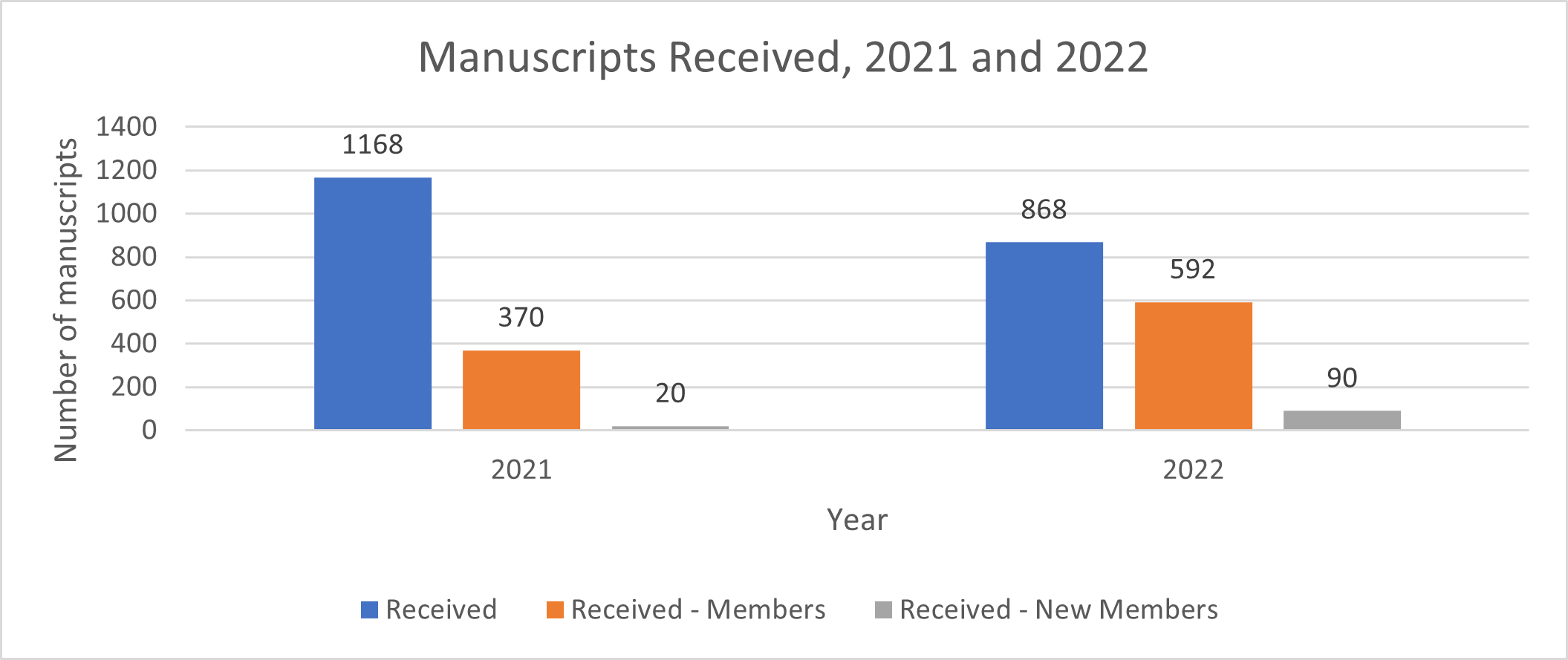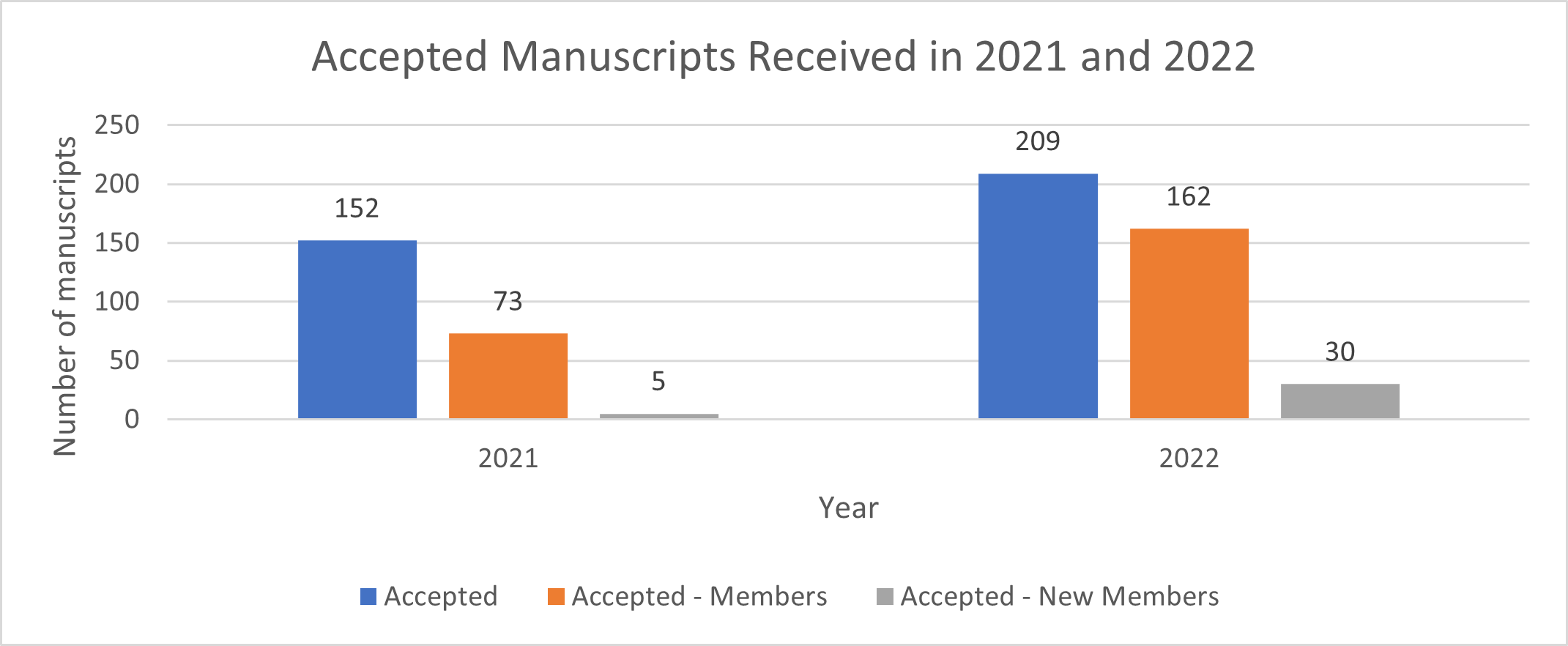Introduction and Background
The business model for publishing has evolved substantially in the past 20 years. The subscription models for academic journals first changed from primarily print journals to online subscriptions and eventually broadened to include open access (OA) and hybrid journals (a combination of subscription and OA). BioMedCentral and the Public Library of Science (PLoS) were the first to charge article processing charges (APCs) to finance the professional publication process as a means to offset the loss of subscription income.1 In 2012, the American College of Gastroenterology (ACG) launched their first OA journal, ACG Case Reports Journal (ACGCRJ), which is dedicated to the publishing of case reports. The journal operates as an online-only Gold OA publication. Initially, the journal did not charge APCs, as its target audience is gastroenterology and hepatology fellows, as well as other early career researchers. Many early career researchers see fees as a disadvantage or roadblock to having work published, and do not see it as a sustainable model due to rising APCs.2 However, as submissions grew and the number of articles published each month increased, production costs to both the publisher and the ACG also increased. Prior to 2022, ACGCRJ had an overall page limit of 46 pages per month. The fee for additional pages was $10,000 and in 2021, ACGCRJ was 86 pages over budget. In an effort to keep the publication sustainable, in 2022, ACGCRJ initiated APCs for articles accepted for publication. However, being mindful of its audience, the ACGCRJ APC was set at $500 and is waived for corresponding authors who are ACG members, authors whose submissions are transferred from another ACG journal, and authors whose submissions were initially received prior to January 1, 2022, when the APC was rolled out. The page budget would remain in place for articles published that were submitted by members, but since nonmembers would be paying an APC, the page budget would no longer apply to those. We sought to study how this altered the landscape of both submissions and published authors in terms of ACG members versus nonmembers.
APCs are the most common funding method for this type of journal, and the current global average of APCs is $1,626.3 For a more direct comparison, the APCs of 4 U.S. publishers of scientific research were analyzed using the criteria that the journals were case reports-focused and OA. Sixty-three journals were examined using data from the OA pricing lists of their respective publishers, and the average APC was $928 (see Supplemental Material). There are several types of exceptions to journal APC policies. All journals analyzed offer partial or full APC waivers for submissions from authors in developing countries, using criteria based on World Bank rankings, the Human Development Index, the Healthy Life Index, and/or the United Nations developed countries lists (see Supplemental Material). Additionally, many scientific journals offer partial APC discounts on submissions from members of their associated societies. Of the 63 journals studied, 13 offered discounts of 20%–50% for submissions from society members, but none offered full APC waivers for society members.
Membership versus APC costs
ACG membership has a variable cost based on career status and location as shown in the Table. Individuals seeking the resident/trainee membership must adhere to specific parameters. Residents must be enrolled in approved training programs with some exposure to gastroenterology-related fields, and trainees must be enrolled in an approved gastroenterology fellowship program.4 Unlike other levels of membership, these applications are reviewed bi-weekly and are approved quickly if the trainee has provided confirmation of enrollment in an appropriate fellowship or training program.
Table. Types of American College of Gastroenterology membership and their associated application fees and annual membership dues as of September 2023.
| Membership Type | Application Fee, $ | Annual Dues, $ | Review Period |
| Associate | 95.00 | 150.00 | Quarterly |
| Advanced Practice Provider | 95.00 | 150.00 | Quarterly |
| Resident/Trainee | 25.00 | 25.00 | Bi-weekly |
| Member | 195.00 | 325.00 | Quarterly |
| International Member* | 150.00 | 250.00 | Quarterly |
| FACG† | 50.00 | 325.00 | Quarterly |
| Senior Member or Fellow | – | – | |
| Master | – | – |
*Individuals from countries classified by the World Bank as lower to middle income pay a $50.00 application fee and $95.00 annual dues.
†Fellows (FACG) pay annual dues of $325.00 regardless of where they live.
The editorial board of ACGCRJ is composed of second, third-, and fourth-year gastroenterology fellows, and the journal’s target audience for both readers and authors are early-career individuals in gastroenterology and hepatology. Since the cost of the application and 1 year of dues for resident/trainee membership is 10% of the cost of the APC, there was reasonable anticipation of an increase in both ACG membership and submissions from new members.
Methods
Submission and acceptance data were tracked using the Editorial Manager platform (Aries Systems), and results were cross-referenced with ACGs membership database. To determine if individuals were obtaining ACG membership to avoid the potential APC, submissions were cross-referenced with the join dates of their corresponding authors using name, institution, and email address as identifiers. Authors are asked during the submission process if they are an ACG member and if they can provide a membership number. The editorial office verifies this upon acceptance. Authors are made aware of the $500 APC during the submission process and are required to select “yes” or “no” via radio button when asked if they agree to the OA charges. If they select “no,” they cannot proceed with submission. Since this choice is made during the initial submission process, new members are defined in associated figures as individuals who joined ACG within 1 month of submitting their manuscript. Figure 1 shows submission data for new and revised manuscripts received in 2021 and 2022.

Results and Discussion
In 2021, ACGCRJ received 1,168 manuscripts with 370 (32%) coming from ACG members, 20 (2%) of which were from new members. In 2022, the journal received 868 manuscripts with 592 (68%) coming from members, 90 (10%) of which were from new members. This represents an increase of 36% in submissions from all members and an increase of 8% among new members. Similar increases were seen in the manuscripts which were eventually published in ACGCRJ, shown in Figure 2.

Of the 1,168 submissions received in 2021, 152 (13%) were eventually accepted. Of the 868 submissions received in 2022, 209 (24%) were eventually accepted, representing an 11% increase in the journal’s overall acceptance rate. As mentioned earlier, the page budget no longer applied to nonmember articles; therefore, the editors were encouraged to accept and ultimately publish more manuscripts overall.
In 2021, 73 (48%) of accepted manuscripts were from ACG members, 5 (7%) of which were from new members. In 2022, 162 (78%) of the accepted manuscripts were from ACG members, 30 (18%) of which were from new members. This represents a 30% increase in overall accepted submissions from ACG members and an 11% increase from new members.
Even accounting for the 11% increase in the overall acceptance rate, ACGCRJ still saw noticeable increases in both the proportion and number of published manuscripts from members and new members.
It is important to note that the drop in overall submission rate in 2022 is consistent across the landscape of scientific publishing. Submission rates across the board saw a jump in 2020 and 2021 due to a variety of factors related to the coronavirus 2019 pandemic. ACGCRJ 2022 submission levels dropped 26% versus 2021 and 42% versus 2020; however, they rebounded in 2023 and are projected to rise by ~18% from 2022. Web of Science data show similar trends across published original research, editorials, and reviews, increasing 10% in 2020, 8% in 2021, and then dropping 6% in 2022 (A Manieri, personal communication).5
Despite a lower overall number of submissions, 2022 saw increases in submissions received from members and submissions from new members. There was also a rise in both the proportion and number of accepted submissions from members and new members.
Limitations and Future Research
The data show that there have been increases in submissions and accepted manuscripts received from members, and it may be inferred that individuals are joining ACG in lieu of paying the $500 APC. As it stands, the current waiver program allows ACGCRJ to publish more articles than before its inception while maintaining financial solvency.
It is no question that debates over APCs are part of a broader discussion on how to make scientific publishing accessible to the wider public, and the costs associated with publishers’ services need to be accounted for in this process as alternatives to APCs are examined. ACGCRJ is an outlet for members of ACG. By becoming a member instead of paying the APC, they become part of the institution that is producing the paper and receive a member benefit that grows with each paper they choose to publish in ACGCRJ.
That said, the motivations of individuals purchasing ACG membership cannot be assumed without surveying those who joined to discern specific reasons. It would be challenging to obtain this data because there are a multitude of benefits to society membership including resources such as webinars, short courses, waived annual meeting fee, print and online subscriptions to the flagship journal The American College of Gastroenterology, access to member publications, and networking opportunities with other members.
In the future, a member survey may include a query about whether or not this particular benefit was a motivation for joining. It may also be useful to study other journals who have initiated such charges and associated discounts or waivers to observe their changes in membership.
Conclusion
Current data support the idea that individuals may join the ACG to avoid paying the OA APC. Societies may see increases in membership if offering APC waivers or discounts for individuals who are members of their organizations.
Prior Presentation
This paper was previously presented as a poster at the Council of Science Editors annual meeting in Toronto, ON, Canada, April 29–May 2, 2023.
References and Links
- Björk BC, Solomon D. Open access versus subscription journals: a comparison of scientific impact. BMC Med. 2012;10:73. https://doi.org/10.1186/1741-7015-10-73.
- Nicholas D, Rodríguez-Bravo B, Watkinson A, et al. Early career researchers and their publishing and authorship practices. Learned Publ. 2017;30:205–217. https://doi.org/10.1002/leap.1102.
- Morrison H, Borges L, Zhao X, Kakou TL, Shanbhoug AM. Open access article processing charges 2011–2021. Sustaining the Knowledge Commons, 2021. [accessed January 23, 2024]. https://sustainingknowledgecommons.org/2021/06/24/open-access-article-processing-charges-2011-2021/.
- https://gi.org/membership/join-acg/
- Web of Science Total Documents Published 2018–2022.
Neen LeMaster, MLIS, Morgan Huntt, BA, and Claire Neumann, MA, are with American College of Gastroenterology, Bethesda, MD.
Opinions expressed are those of the authors and do not necessarily reflect the opinions or policies of the Council of Science Editors or the Editorial Board of Science Editor.
